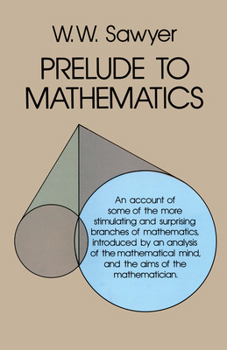Prelude to Mathematics
Select Format
Select Condition 
Book Overview
"No mathematician can be a complete mathematician unless he is also something of a poet." -- K. Weierstrass
In this lively and stimulating account, noted mathematician and educator W. W. Sawyer (Professor Emeritus, University of Toronto) defines mathematics as "the classification and study of all possible patterns." It is a broad definition, but one that seems appropriate to the great scope and depth of the topic. Indeed, mathematics seems to have few boundaries, either in applications to practical matters or in its mind-stretching excursions into realms of pure abstraction.
Gearing his approach to the layman whose grasp of things mathematical may be a bit precarious, Professor Sawyer offers a lucid, accessible introduction to the mathematician's cast of mind. Five well-written preliminary chapters explore the beauty, power and mysticism of mathematics; the role of math as an adjunct in utilitarian matters; and the concepts of pattern, generalization and unification as both tools and goals of mathematical thought.
After developing this conceptual groundwork, the author goes on to treat of more advanced topics: non-Euclidean geometry, matrices, projective geometry, determinants, transformations and group theory. The emphasis here is not on mathematics with great practical utility, but on those branches which are exciting in themselves -- mathematics which offers the strange, the novel, the apparently impossible -- for example, an arithmetic in which no number is larger than four.
Mathematicians will appreciate the author's grasp of a wide range of important mathematical topics, and his ability to illuminate the complex issues involved; laymen, especially those with a minimal math background, will appreciate the accessibility of much of the book, which affords not only a portrait of mathematics as a matchless tool for probing the nature of the universe, but a revealing glimpse of that mysterious entity called "the mathematical mind." Professor Sawyer has further enhanced this new Dover edition with updated material on group theory, appearing here in English for the first time.
Customer Reviews
Rated 5 starsa clear introduction to mathematics
Prelude To Mathematics covers many aspects of the field of mathematics including modular arithmetic, non euclidean geometry, projective geometry, matrices and determinants. In addition the author discusses common themes in mathematics including pattern, generalization and unification. Although the types of mathematics are introduced in different chapters the author draws them together several times in the book making for a...
0Report
Rated 5 starsAbout That Delta Square Business! :-)
Well, this really is a terrific book. Lots of simple ideas very well explained. He spells out the notion of pattern quite well, and what it means in terms of mathematics. It seems many modern authors just state that math is about patterns and leave it at that. He seems to get to the point on many subjects that a reader has in the back of his mind as he reads about the material. I'm not sure this book is really intended...
0Report
Rated 5 starsI MUST HAVE COME ACROSS THIS YEARS AGO WHEN
the material in it was over my head, but I had forgotten about it. What a treasure!! MATHEMATICIAN'S DELIGHT is more famous, I believe, but this book is filled with wisdom. Sawyer introduces finite geometries and group theory in simple prose. He figures out where Hall and Knight came up with the ideas for some of their exercises in their (famous) HIGHER ALGEBRA text. He introduces the hypergeometric function as a generalization...
0Report
Rated 5 starsI finally found a modern rival for Sawyer!
I got Sawyer's book used in a book store and for 15 years I have used it's wisdom in my work on non Euclidean geometry, fractals and group theory. I just got " Elliptic Curves" by Mc Kean and Moll. For once a Cambridge book that doesn't eat dust! It is so hard to read papers by Yau that one gives up! Most Modern mathematics is written by people who can't communicate... Sawyer is a guide for writers of mathematics... how...
0Report
Rated 5 starsThe best introductory math book!
This is the book that really got me interested in mathematics. I had never thought that a math book could be so engrossing. I finished reading it in a couple days and i immediately seeked out the author's other books. And the quality of the other book are of the same level as this one. It is a shame that the author's other books are mostly out of print. What i appreciate most about the book is that the math concepts are...
0Report












